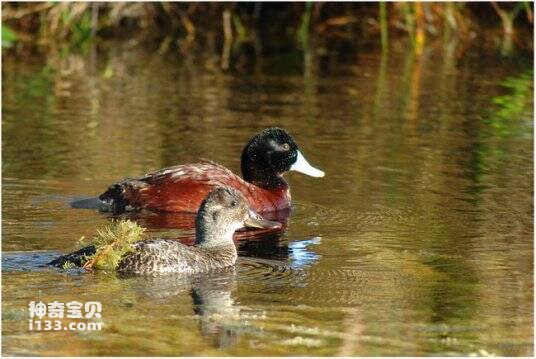Oxyura australis
IUCN
LCBasic Information
Scientific classification
- name:Oxyura australis
- Scientific Name:Oxyura australis,Blue-billed Duck
- Outline:Waterfowl
- Family:
Vital signs
- length:35-44CM
- Weight:810-850g
- lifetime:About 16 years
Feature
The male has a large, bright, compact pale blue bill with dark chestnut feathers over most of the body, dark orange on the head and upper neck, brown on the belly, and white areas in the center
Distribution and Habitat
It is found in Australia and New Zealand, including Tasmania and its nearby islands.
Inhabiting open deep freshwater lakes, DAMS, inland rivers, ponds, swamps, etc., it is almost entirely aquatic and rarely seen on land.
Appearance
The Australian blue-billed duck is 35-44 cm long with a 60 cm wingspan and weighs 850 grams for males and 810 grams for females. Life span 16 years. It has reddish feathers and a black head. The male has a large, bright, compact pale blue bill with dark chestnut feathers over most of the body, dark orange on the head and upper neck, brown on the belly, and white areas in the center. The tail feathers are stiffly raised and usually level with the water. Female ducks have darker plumage than male ducks and each feather, the duck's bill is brown with narrow lines of light brown. The upper tail is black, with black spots on the chin and throat.
The male duck has a black sheen on the head and neck, and a strong chestnut color on the back and wings. During the non-breeding season, the smooth black head has gray spots and the body changes from chestnut to dark gray. Some males retain their breeding feathers throughout the year. The female's plumage does not change throughout the
Details
The Australian hard-tailed Duck (Oxyura australis) is a Blue-billed Duck, without subspecies.

The breeding ground of the Australian hardtail duck is chosen in the quiet and dense vegetation. It nests in the marsh on the water's edge, in the scrub or in the grass, and builds a solid floating nest made of reeds. The nests are usually laid with dried cattails and are polygamous, and the breeding period is from May to July. Each clutch lays 6-10 eggs. Incubation period is 25 days.
Listed on the International Union for Conservation of Nature (IUCN) 2012 Red List of Threatened Species ver3.1 - Near Threatened (NT).
Protect wild animals and eliminate wild meat.
Maintaining ecological balance is everyone's responsibility!








